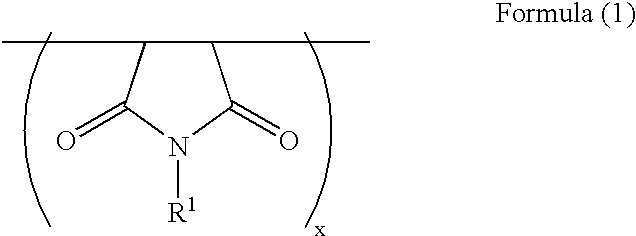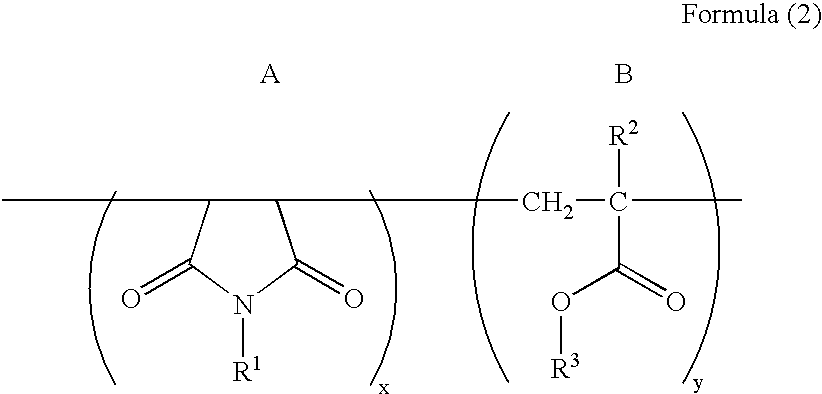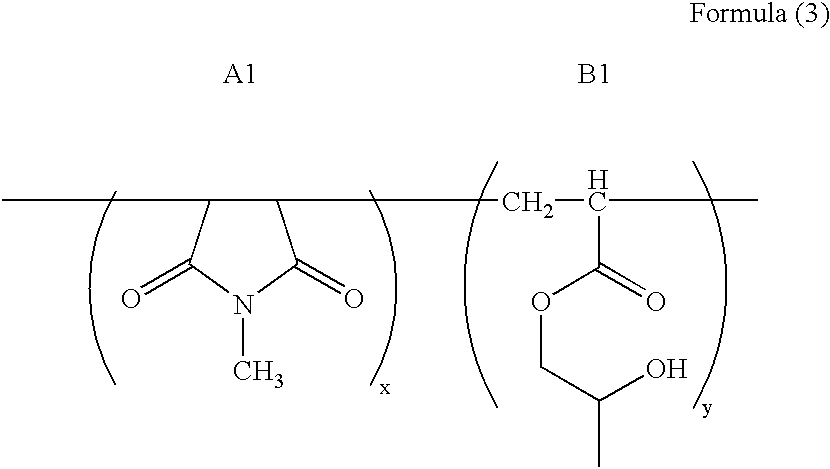Bottom anti-reflective coat forming composition for lithography
a technology of anti-reflective coating and composition, which is applied in the direction of photosensitive materials, instruments, photomechanical equipment, etc., can solve the problems that the high-performance of lsi with the present technology for the production of lsi has become difficult, and achieves the effects of excellent resist pattern, rapid removal, and high-effective preventive effect of reflected ligh
- Summary
- Abstract
- Description
- Claims
- Application Information
AI Technical Summary
Benefits of technology
Problems solved by technology
Method used
Image
Examples
synthetic example 1
[0054]N-methylmaleimide (produced by Tokyo Kasei K.K.) and hydroxypropyl acrylate (produced by Jyunsei Chemical K.K.) were prepared.
[0055]33.9 g (0.305 mole) of said N-methylmaleimide and 66.1 g (0.508 mole) of said hydroxypropylacrylate were dissolved in 350 g of tetrahydrofuran, and then temperature of the flask was elevated to reflux temperature under nitrogen atmosphere. 1 g of azobisisobutyronitrile (AIBN) dissolved in 50 g of tetrahydrofuran was added under pressured nitrogen after the initiation of reflux, and reaction was continued for 24 hours. Upon cooling the reaction solution, the solution was introduced into diethylether, the polymer was re-precipitated, dried with heat, and then the polymer comprising the structural unit shown in the Formula (3) was obtained. Weight-average molecular weight of the polymer was 5400. The structural unit A1=37.5 mol %, the structural unit B1=62.5 mol %, and yield was 90%.
synthetic example 2
[0056]N-ethylmaleimide (produced by Tokyo Kasei K.K.) and hydroxypropyl methacrylate (produced by Jyunsei Chemical K.K.) were prepared.
[0057]50 g (0.400 mole) of said N-ethylmaleimide and 50 g (0.347 mole) of said hydroxypropylmethacrylate were dissolved in 350 g of tetrahydrofuran, and then temperature of the flask was elevated to reflux temperature under nitrogen atmosphere. 1 g of azobisisobutyronitrile dissolved in 50 g of tetrahydrofuran was added under pressured nitrogen after the initiation of reflux, and reaction was continued for 24 hours. Upon cooling the reaction solution, the solution was introduced into diethylether, the polymer was re-precipitated, dried with heat, and then the polymer comprising the structural unit shown in the Formula (4) was obtained. Weight-average molecular weight of the polymer was 6200. The structural unit A2=53 mol %, the structural unit B2=47 mol %, and yield was 90%.
synthetic example 3
[0058]Hydroxyethylmaleimide (produced by OGRGANIX) and hydroxypropyl acrylate (produced by Jyunsei Chemical K.K.) were prepared.
[0059]55 g (0.400 mole) of said hydroxyethylmaleimide and 50 g (0.347 mole) of said hydroxypropylacrylate were dissolved in 350 g of tetrahydrofuran, and then temperature of the flask was elevated to reflux temperature under nitrogen atmosphere. 1 g of azobisisobutyronitrile dissolved in 50 g of tetrahydrofuran was added under pressured nitrogen after the initiation of reflux, and reaction was continued for 24 hours. Upon cooling the reaction solution, the solution was introduced into diethylether, the polymer was re-precipitated, dried with heat, and then the polymer comprising the structural unit shown in the Formula (5) was obtained. Weight-average molecular weight of the polymer was 5100. The structural unit A3=53 mol %, the structural unit B3=47 mol %, and yield was 90%.
PUM
| Property | Measurement | Unit |
|---|---|---|
| mol % | aaaaa | aaaaa |
| mol % | aaaaa | aaaaa |
| wave-length | aaaaa | aaaaa |
Abstract
Description
Claims
Application Information
 Login to View More
Login to View More - R&D
- Intellectual Property
- Life Sciences
- Materials
- Tech Scout
- Unparalleled Data Quality
- Higher Quality Content
- 60% Fewer Hallucinations
Browse by: Latest US Patents, China's latest patents, Technical Efficacy Thesaurus, Application Domain, Technology Topic, Popular Technical Reports.
© 2025 PatSnap. All rights reserved.Legal|Privacy policy|Modern Slavery Act Transparency Statement|Sitemap|About US| Contact US: help@patsnap.com



